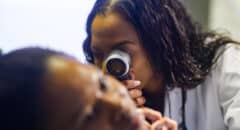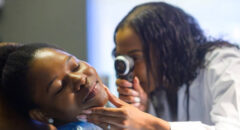 Spots and dots, being a freckled-faced person I am no stranger to these kinds of beauty marks. But, understanding the difference between unique beauty features, and dangerous moles can be difficult, yet so very important to our health. Our bodies can have a strange way of expressing themselves, and often times (unbeknownst to us) moles are your bodies way of letting know something serious is going on.
Spots and dots, being a freckled-faced person I am no stranger to these kinds of beauty marks. But, understanding the difference between unique beauty features, and dangerous moles can be difficult, yet so very important to our health. Our bodies can have a strange way of expressing themselves, and often times (unbeknownst to us) moles are your bodies way of letting know something serious is going on.
MUST READ: Beauty Mark Or Genetic Mutation?
A true beauty mark is with us since birth, but as we age we can develop marks and spots on our body that could mean anything or nothing. There is an old wives tale that suggests that raised moles are the ones to worry about. Well according to New York-based dermatologist, Neal Schultz, this is just that, a tale. According to Dr. Schultz,”It’s usually the flat moles that get into trouble. Raised moles are intradermal moles, or compound moles, and they have a much lower rate of malignant degeneration. Flat moles are where most of the cases of melanoma come from.”
What Does a ‘Normal’ Mole Look Like?
A normal mole is typically:
- Even in color (tan, brown, or black)
- Round or oval in shape
- Flat or slightly raised
- Smaller than a pencil eraser
- Unchanging over time – Moles usually appear during childhood or adolescence and may darken slightly with age or sun exposure.
The ABC’s of Cancerous Moles
When looking to see if your mole is healthy or not, just turn to your ABC’s:
A is for Asymmetry:
Is one half of the mole the same same and shape as the other half? If not, you may want to a doctor to look at it
B is for Border:
Are the border or edges of the mole smooth or jagged and bumpy? If they are not smooth, another cause for concern.
C is for Color:
Is the mole one color or multiple colors? The more colors in one mole is enough reason to look further into it.
D is for Diameter:
If the size of the mole is bigger than the size of a pencil’s eraser, then pay attention to other signs and find out what your physician thinks of it
E is for Evolving:
Any change—size, shape, color, elevation, or new symptoms like bleeding or itching—deserves medical attention.
How to Tell If Your Mole Healthy
Some strong signs to pay attention to are number one, symmetry. A healthy mole will be shaped in a way that if cut in half they would be equal and mirror each other. Oddly and awkwardly shaped moles are ones you should definitely point out to your physician. And according to Dr. Scultz you can take this symmetry test even further. He suggests that “if you draw a line down the middle of your body, from your chin down through your groin, and you have two moles that are a mirror of each other, meaning roughly the same distance from that middle line and approximately the same level up and down, there is a good chance they are precancerous.”
Another thing to pay attention to is change. A healthy mole will remain the same forever. Even if you cut or agitate it by mistake, it should heal and go back to the exact same shape/color that it was to begin with. If you notice that a mole is changing over time, it may be worth showing your doctor.
Other Symptoms That May Signal Skin Cancer
Beyond the ABCDEs, pay attention to these additional red flags:
- A new mole that looks different from your other moles (“the ugly duckling” sign)
- A mole that bleeds, oozes, or scabs
- A mole that becomes painful, itchy, or tender
- A mole with a shiny, firm, dome-shaped surface (possible basal cell carcinoma)
- A rough or scaly patch that doesn’t heal
When to See a Dermatologist
If you notice any changes or suspicious spots, schedule a skin exam with a dermatologist right away. They may perform a biopsy, where a small tissue sample is removed and tested to confirm whether it’s cancerous.
It’s also wise to:
- Get a full-body skin check annually, especially if you have fair skin, a history of sunburns, or a family history of skin cancer.
- Take monthly self-checks in good lighting and use mirrors to inspect hard-to-see areas.
Prevention Tips
- Use sunscreen daily (SPF 30 or higher).
- Avoid tanning beds.
- Wear protective clothing and wide-brimmed hats outdoors.
- Know your skin. Familiarity helps you spot new or changing moles early.
MUST READ: Men & Melanoma: What To Know Before Going Shirtless
It is important that you stay aware of your skin’s health. I mean, it is the largest organ we have. Making sure to pay attention to anything that seems off or different about your skin is helpful for you to stay on top of your health. If you really want to be an Allstar see a dermatologist once a year just as you would your family doctor for a physical. It can’t hurt to know that you are in the clear! Most issues caught early can be resolved, so do your best to stay in the know about your health!








